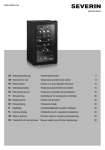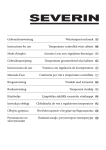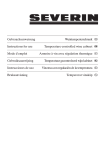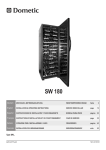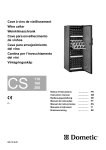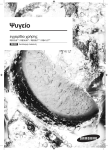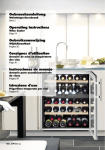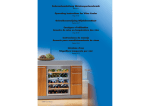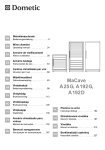Download SEVERIN Temperature-controlled wine cabinet Product data
Transcript
www.severin.com welcome home DE Gebrauchsanweisung Weintemperierschrank 3 GB Instructions for use Temperature-controlled wine cabinet 8 FR Mode d’emploi Armoire à vin avec régulation thermique 13 NL Gebruiksaanwijzing Temperatuur gecontroleerd wijn kabinet 18 ES Instrucciones de uso Vinoteca con regulación de la temperatura 23 IT Cantinetta per vini a temperature controllata 28 DK Brugsanvisning Vinskab med termostat 33 SE Bruksanvisning Tempererat vinskåp 38 FI Lämpötilansäätimellä varustettu viinikaappi 43 PL Instrukcja obsługi Chłodziarka do win z regulatorem temperatury 48 GR Oδηγίες χρήσεως Ντουλάπι κρασιών ελεγχόμενης θερμοκρασίας 53 RU Руководство по эксплуатации Винный шкаф с регулятором температуры 58 Manuale d’uso Käyttöohje GB Temperature-controlled wine cabinet Dear Customer, Before using the appliance, please read the following instructions carefully and keep this manual for future reference. The appliance must only be used by persons familiar with these instructions. Connection to the mains supply ∙ The appliance should only be connected to an earthed socket installed in accordance with the regulations. Make sure that the supply voltage corresponds with the voltage marked on the rating label. ∙ This product complies with all binding CE labelling directives. ∙ Do not operate this unit by means of a transformer or, together with other electrical appliances, by means of an extension cable. ∙ To prevent noise vibration, ensure that the power cord does not touch any part of the rear of the unit (e.g. the heatexchanger). General information ∙ This appliance is a compressor refrigerator designed for cooling and storing wine only. ∙ Refrigeration appliances are classified into certain climate classes. Please refer to the product data sheet for information on the classification for this unit. ∙ This appliance is intended for domestic or similar applications, such as - in shops, offices and other similar working environments, - in agricultural working environments, - by customers in hotels, motels etc. and similar establishments, - in bed-and breakfast type environments. ∙ This appliance is not intended for commercial use, nor for use in the catering business or similar wholesale environments. ∙ No responsibility is accepted if damage results from improper use, or if these instructions are not complied with. Important safety instructions ∙ Before it is connected to the mains power, the unit must be thoroughly checked for transport damage, including its power cord. In the event of any such damage being found, the appliance must not be connected to the mains. ∙ In order to comply with safety regulations and to avoid hazards, any repairs or modifications to this unit must be carried out by our authorised service personnel, including the replacement of the power cord. ∙ Remove the plug from the wall socket 8 ∙ ∙ ∙ ∙ ∙ ∙ - in case of any malfunction, - during cleaning, - before maintenance or repair work is carried out. To avoid the risk of electric shock, do not clean the appliance with water and do not immerse it in water. The power cord should be regularly examined for any signs of damage. In the event of such damage being found, the appliance must no longer be used. This appliance may be used by children (at least 8 years of age) and by persons with reduced physical, sensory or mental capabilities, or lacking experience and knowledge, provided they have been given supervision or instruction concerning the use of the appliance and fully understand all dangers and safety precautions involved. Children must not be permitted to play with the appliance. Children must not be permitted to carry out any cleaning or maintenance work on the appliance unless they are supervised. The cooling circuit in this appliance contains the refrigerant isobutane (R600a), a natural gas with a high level of environmental compatibility, which is nevertheless flammable. Ensure, therefore, that none of the components of the refrigerant circuit become damaged during transportation and installation of the appliance. If damage to the cooling circuit does occur, do not switch on or connect the appliance to the mains power. If there should be an open fire or any other sources of ignition in the vicinity of the refrigerant gas, make sure it is removed immediately from the area and that the room is then thoroughly ventilated. ∙ To prevent the risk of personal injury or damage to the cabinet, the unit must only be transported while in its original packaging. For unpacking and installation, 2 persons are needed. ∙ Caution: Keep any packaging materials well away from children: there is a risk of suffocation. ∙ Warning: Do not damage the cooling circuit. Any escaping ∙ ∙ ∙ ∙ ∙ refrigerant causes damage to the eyes; there is also a danger of the gas igniting. Warning: Keep the ventilation openings in the appliance enclosure clear of obstruction. Sufficient ventilation must be ensured at all times. Warning: Do not use any external device (e.g. heaters or heating fans) to accelerate de-frosting; follow only the methods recommended in this manual. Warning: Do not operate any other electrical appliances (e.g. ice makers) inside the cabinet. Caution: do not remove the cover of the interior LED light. If there should be any malfunction, please contact the customer service for assistance. To avoid the risk of fire, do not place any thermo-electric appliances on top of the unit. Do not place liquid containers ∙ ∙ ∙ ∙ ∙ ∙ ∙ on top of the unit, to prevent any leaking or escaping liquid damaging the electrical insulation. This appliance is designed for storing wine only. Do not lean or put undue weight on the shelves, door etc. Protect the inside of the wine cabinet at all times from open flames and any other sources of ignition. When removing the plug from the wall socket, never pull on the power cord; always grip the plug itself. We reserve the right to introduce technical modifications. If the unit is not used for an extended period of time, we recommend keeping the door open. If the unit is sold, handed over to a third party or disposed of at a suitable recycling facility, attention must be drawn to the presence of the insulation agent ‘cyclopenthane’ as well as to the refrigerant R600a. Familiarisation 1. 2. 3. 4. 5. 6. 7. 8. 9. 10. 11. Door hinge cover Door hinge Double-walled glass door Power cord Adjustable feet Chrome-plated storage racks Housing Drain channel Compressor Interior lighting with On/Off switch Temperature control Before using for the first time ∙ Remove any exterior and interior packaging materials. ∙ Please ensure proper disposal of all packaging materials. ∙ Clean the unit according to the instructions given in the Defrosting and cleaning section below. ∙ The unit should only be transported in its vertical position; do not tilt any more than 30°. ∙ Once the unit has been positioned, wait for about 30 minutes before it is connected to the mains. ∙ If the unit has been tilted more than 30° during transport, allow it to stand upright for at least 4 hours before it is 9 connected to the mains. ∙ When the unit is first switched on, a slight ‘new’ smell may be noticed. However, this will disappear once the cooling process has begun. Installation ∙ The appliance should be set up in a well-ventilated, dry room. ∙ It should be operated in conditions where the relative humidity is no more than 70 %. ∙ The product data sheet contains details of the ambient temperature range suitable for this appliance. ∙ Do not use the appliance outdoors. ∙ Ensure that the plug is accessible and can be removed from the wall socket at any time. ∙ Do not expose the appliance to direct sunlight, and do not position it next to any heat sources (radiators, cookers etc). If this cannot be avoided, however, suitable insulation must be in installed between the heat source and the unit. ∙ The unit must not be installed inside a cabinet, nor directly below a hanging cupboard, shelf or similar object. ∙ Ensure that the door can swing open to an angle of 90°. ∙ If the floor is uneven, the adjustable feet on the unit can be used to compensate and ensure optimum stability. Ventilation The heated air around the unit must be able to circulate freely. Therefore, ensure that the circulation around and above the unit is not obstructed. The clearance must be at least 150 mm. Temperature control ∙ The unit is activated by connecting it to the mains. It is only switched off completely when the plug is removed from the wall socket. ∙ The temperature in the refrigerator cabinet can be adjusted by setting the temperature control (1-7). Turning the control clockwise will decrease the temperature, while turning it anticlockwise will increase it. ∙ The temperature can be set within a 5 to 18°C range. ∙ The temperature in the cabinet largely depends on factors such as the ambient temperature, the setting and the number of wine bottles stored. ∙ We recommend using a thermometer to check the actual temperature inside the cabinet and make adjustments as necessary. ∙ Always ensure that the door is properly closed and that the seal is not obstructed by bottles stored inside the cabinet. ∙ Following a power interruption, or if the unit has been switched off on purpose, it may take 3 to 5 minutes before it switches on again. ∙ Note: In position ‘0’, the cooling function is switched off, though the appliance is still connected to the mains. Interior lighting ∙ The interior light can be switched on by means of the separate On/Off switch. ∙ Caution: do not remove the cover of the interior LED light. If there should be any malfunction, please contact the customer service for assistance. 10 Storing wine The following temperatures are suitable for various wines: Red: 15 -18°C Dry/white: 10 -15°C Sparkling/champagne: 5 - 9°C De-frosting and cleaning ∙ During operation, you may notice a build-up of frost around the integral evaporator sealed into the rear of the inside cabinet. This layer of frost will start melting when the compressor is not working. Through a system of hoses, the melt-water drains into the collection tray below the compressor, where it will be absorbed into the surrounding air. ∙ The unit does not therefore require de-frosting, but only proper cleaning. ∙ To enable the melt-water to drain freely, always ensure that the channel and discharge opening in the cabinet are free of any blockage. ∙ Any water collecting in the bottom should be removed. ∙ Remark: Do not use abrasive tools, materials containing alcohol or harsh cleaning solutions. Do not use any electrical appliances, such as steam cleaners, for de-frosting or cleaning. ∙ Always remove the plug from the wall socket before cleaning. ∙ Do not pour water over or inside the unit. ∙ For frequent cleaning we recommend the use of warm water with some mild detergent. ∙ The cabinet should be cleaned once a month. ∙ Any accessories should be cleaned separately with soapy water. Do not put them in a dishwasher. ∙ After cleaning, thoroughly clean all surfaces with fresh water before wiping them completely dry. When re-inserting the plug into the wall socket ensure that you have dry hands. ∙ To save energy and to ensure optimum performance, the compressor (at the rear) should be carefully cleaned at least twice a year, with a brush or a vacuum cleaner. Trouble-shooting ∙ Certain typical sounds can be heard when the appliance is switched on. These sounds are caused by: ∙ the electric motor within the compressor assembly; during compressor start-up the sound level will be slightly higher for a short time. ∙ the cooling agent flowing through the circuit. ∙ In addition, the side of the housing may become warm. This heat is caused by dissipation of the heat generated inside the cabinet. The following table lists possible malfunctions, their probable causes and solutions. In the event of operational problems, check first whether a solution can be found using this table. If the problem persists, disconnect the appliance from the mains power and contact our Customer Service Department. Problem The appliance is not working at all. Possible cause and solution ∙ ∙ ∙ ∙ ∙ ∙ The temperature inside the compartment ∙ is not low enough. ∙ ∙ There is a power failure The main fuse has blown. The temperature control is set to ‘0‘. The fuse in the wall socket (if applicable) has blown. This can be checked by connecting another electrical device to the socket and checking for function. The cabinet has been overloaded. The doors are not properly closed. There is too much dust on the condenser. Insufficient ventilation: the unit is too close to a wall or other structure or object. The temperature setting is too low The normal operating sound changes or becomes louder. Check the following: ∙ Check for proper positioning (uneven floor). ∙ Are any adjacent objects affected by the running of the cooling unit (i.e. causing them to vibrate?) ∙ Are there any objects on top of the unit which might be vibrating? Water is collecting on the bottom of the unit. The melt-water drain system is blocked. Remove the blockage and clean the system. Transporting the appliance To prevent damage to the unit during transport, ensure that all accessories and components inside and around the appliance are securely fastened. The unit must only be transported in its vertical position; do not tilt any more than 30°. Once the unit has been positioned, wait for about 30 minutes before it is connected to the mains. If the unit has been tilted more than 30° during transport, allow it to stand in an upright position for at least 4 hours before it is connected to the mains. Disposal Devices marked with this symbol must be disposed of separately from your household waste, as they contain valuable materials which can be recycled. Proper disposal protects the environment and human health. Your local authority or retailer can provide information on the matter. The refrigerant and the chemical agent in the insulation foam must be disposed of through a competent agency. Take special care not to damage the cooling circuit before the unit is handed over for competent disposal. Guarantee This product is guaranteed against defects in materials and workmanship for a period of two years from the date of purchase. Under this guarantee the manufacturer undertakes to repair or replace any parts found to be defective, providing the product is returned to one of our authorised service centres. This guarantee is only valid if the appliance has been used in accordance with the instructions, and provided that it has not been modified, repaired or interfered with by any unauthorised person, or damaged through misuse. This guarantee naturally does not cover wear and tear, nor breakables such as glass and ceramic items, bulbs etc. This guarantee does not affect your statutory rights, nor any legal rights you may have as a consumer under applicable national legislation governing the purchase of goods. If the product fails to operate and needs to be returned, pack it carefully, enclosing your name and address and the reason for return. If within the guarantee period, please also provide the guarantee card and proof of purchase. Information needed by the Customer Service Should repairs to the appliance become necessary, please contact our Customer Service, providing a detailed fault description and quoting the article number KS ... on the rating plate of the appliance. This information will help us to handle your request efficiently. In case of problems or malfunction, contact only the Service hotline. 11 Product data sheet Art. no. Product category KS 9894 Wine cabinet Energy efficiency classification Energy consumption in kWh/year A 136 The actual consumption depends on the pattern of use and the location of the appliance Usable cabinet capacity (litres) 95 Frost-free : refrigeration unit yes Climate classification Ambient temperature range, °C 10-32°C Noise emission 39 dB(a) Dimensions (H x W x D) in mm Weight (kg) Electrical specifications 12 N, SN 840 x 480 x 470 29.3 See rating plate






